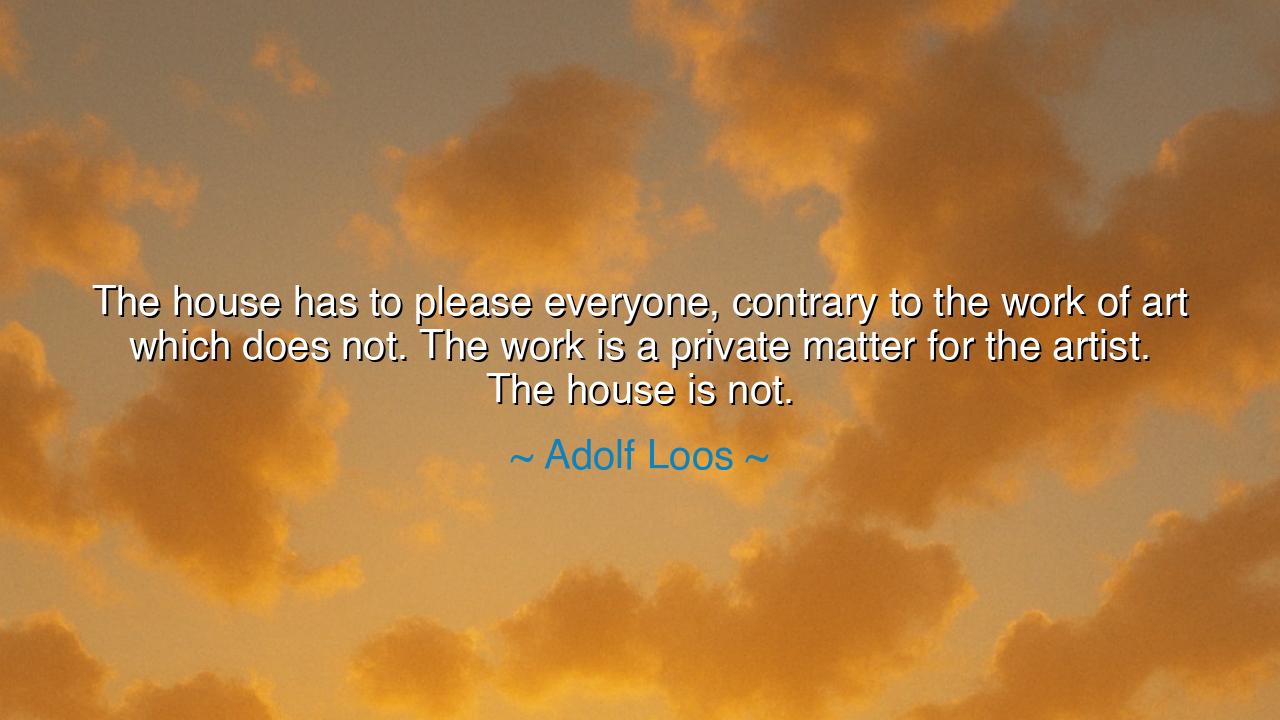
The house has to please everyone, contrary to the work of art
The house has to please everyone, contrary to the work of art which does not. The work is a private matter for the artist. The house is not.






When the architect and philosopher Adolf Loos declared, “The house has to please everyone, contrary to the work of art which does not. The work is a private matter for the artist. The house is not,” he spoke as one who understood both the beauty and the burden of creation. His words are not simply about walls and windows — they are about the eternal tension between individual expression and shared purpose, between the spirit that creates for itself and the hand that builds for others. In this saying lies a truth older than civilization: that art is freedom, but architecture is service. One feeds the soul of the creator; the other shelters the soul of mankind.
Loos lived in an age of rebellion against ornament and excess, a time when artists sought to liberate form from the tyranny of tradition. Yet he, unlike many of his contemporaries, saw the danger in pride untempered by duty. The artist, he said, may create for his own vision — he may wound or astonish, provoke or divide — for his work belongs to his solitude. But the architect does not live in that solitude. He builds for the living — for children who play, for families who eat and rest, for the aged who dream by the fire. The house, therefore, must be a vessel of comfort and belonging, not of vanity. It is not a monument to the designer’s ego, but a sanctuary for human life itself.
In ancient times, this wisdom was already known. The builders of temples and palaces in Egypt or Greece were not celebrated for their names, but for their craftsmanship — for the way they shaped stone to serve both man and god. Their beauty was born not from self-expression, but from harmony — the balance between structure and soul. They built to please the heavens and to sustain the earth. In this, their spirit was humble yet eternal. For the house that serves well endures long after the artist’s name has turned to dust.
Consider, then, the story of Le Corbusier, who came after Loos and dreamed of cities as machines for living. He sought purity and order — the triumph of rational design. Yet when his plans were imposed upon the people, as in the high towers of postwar Europe, something vital was lost. The walls stood tall, but the warmth was gone; the spaces echoed not with life, but with isolation. His works of art were admired, but his houses often failed to please those who lived within them. Here, Loos’s warning rings clear: when the architect forgets that the house is not a personal canvas, the people become strangers in their own homes.
And yet, Loos did not despise beauty — far from it. He sought a purity of design that served human needs first, believing that true beauty emerges naturally from function and proportion. In his mind, a house that pleased everyone did not mean it must be plain or soulless; it meant it must be humane. To design a house, he believed, is to practice empathy — to feel what others will feel when they step inside. The architect, therefore, must be both artist and servant, visionary and caretaker. In this, Loos revealed the nobility hidden in simplicity, the grandeur within humility.
The meaning of his words reaches beyond architecture. For all who create — whether teachers, leaders, parents, or poets — there is a moment when one must decide whether to build for the self or for others. Art dares to confront, to challenge, to transcend; but the house — whether of stone, of community, or of love — must embrace. The house must welcome the stranger, soothe the weary, and stand firm against the storms. To build such a house, in any sense, is the highest act of service a human can perform.
So let this be your lesson, child of craft and thought: know when to create for the self and when to create for all. When you make art, pour into it your fire and freedom — let it be a mirror of your soul. But when you build a house — or anything meant to hold the lives of others — lay aside your pride. Build with care, with patience, and with love. Seek harmony, not glory. For the artist’s work may move hearts, but the builder’s work sustains them. And in the end, it is the house — not the monument — that keeps the flame of humanity alive through every age.






AAdministratorAdministrator
Welcome, honored guests. Please leave a comment, we will respond soon